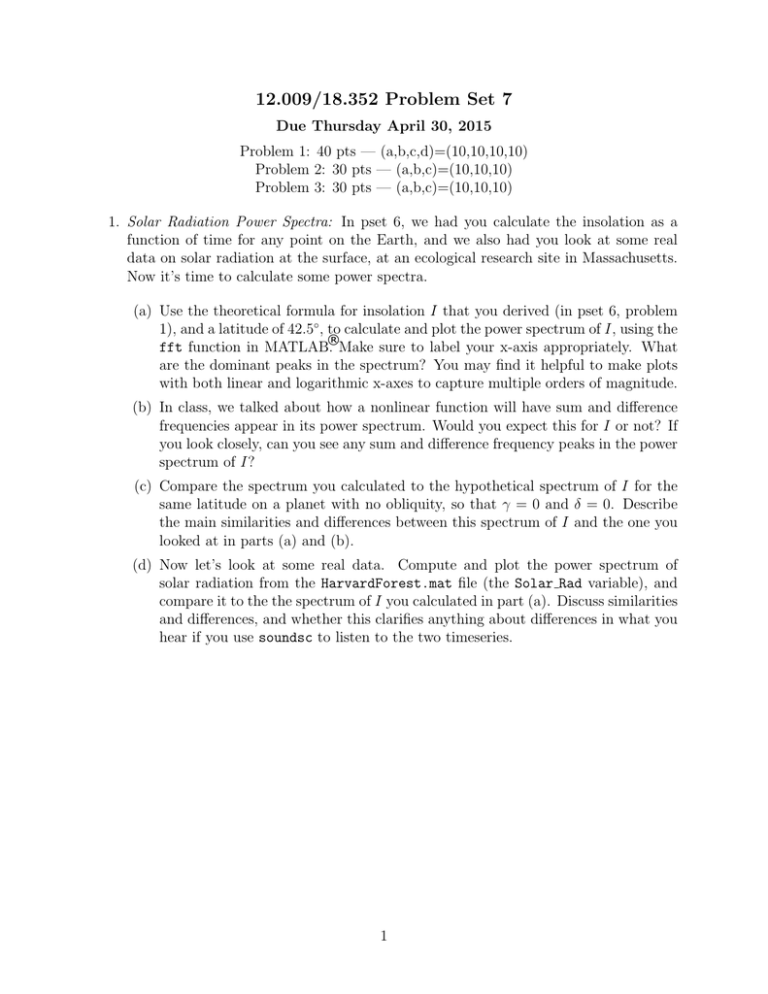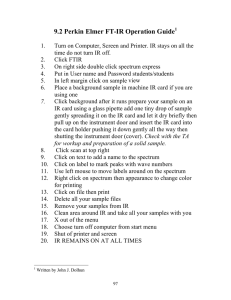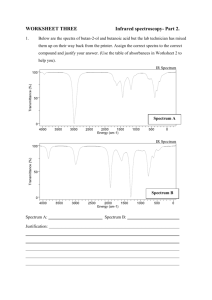12.009/18.352 Problem Set 7
advertisement

12.009/18.352 Problem Set 7 Due Thursday April 30, 2015 Problem 1: 40 pts — (a,b,c,d)=(10,10,10,10) Problem 2: 30 pts — (a,b,c)=(10,10,10) Problem 3: 30 pts — (a,b,c)=(10,10,10) 1. Solar Radiation Power Spectra: In pset 6, we had you calculate the insolation as a function of time for any point on the Earth, and we also had you look at some real data on solar radiation at the surface, at an ecological research site in Massachusetts. Now it’s time to calculate some power spectra. (a) Use the theoretical formula for insolation I that you derived (in pset 6, problem 1), and a latitude of 42.5◦ , to calculate and plot the power spectrum of I, using the fft function in MATLAB. Make sure to label your x-axis appropriately. What are the dominant peaks in the spectrum? You may find it helpful to make plots with both linear and logarithmic x-axes to capture multiple orders of magnitude. (b) In class, we talked about how a nonlinear function will have sum and difference frequencies appear in its power spectrum. Would you expect this for I or not? If you look closely, can you see any sum and difference frequency peaks in the power spectrum of I? (c) Compare the spectrum you calculated to the hypothetical spectrum of I for the same latitude on a planet with no obliquity, so that γ = 0 and δ = 0. Describe the main similarities and differences between this spectrum of I and the one you looked at in parts (a) and (b). (d) Now let’s look at some real data. Compute and plot the power spectrum of solar radiation from the HarvardForest.mat file (the Solar Rad variable), and compare it to the the spectrum of I you calculated in part (a). Discuss similarities and differences, and whether this clarifies anything about differences in what you hear if you use soundsc to listen to the two timeseries. 1 2. Remember the Geysers? Way back when on problem set 1 we looked at the distribution of wait times between eruption events for one of the geysers in Yellowstone Park. By plotting the data in a strange mapping we got at the alternating nature of the long and short eruption times. To refresh your memory, the histogram of wait times looked like this 350 Number of Occurrences 300 250 200 150 100 50 0 0 0.5 1 1.5 Wait Time 2 2.5 x 104 Image by MIT OpenCourseWare. where the wait times are in seconds. We have transformed this into a binary time-series where 1 represents an eruption and 0 no eruption. To keep things sane each 0 or 1 represents a ∆t of one hour. This data can be found in geysertimeseries.m. (a) Using the information in the histogram and your results from problem set 1, explain where you would expect two different peaks in the power spectrum of the time series. (b) Using the fft function in MATLAB, find the power spectrum of the time series. Plot the power-spectra. Make sure to carefully label your axes. Also, make sure to scale the plot so that the interesting peaks are visible. (c) Looking at your plot of the power spectra, explain what causes the peaks you did not explain in part 2a. 2 3. Ice Volume: In class we have looked at various records found in the ice cores which appear to exhibit frequencies consistent with orbital forcing. Specifically, we looked in depth at the record of δ 18 O as a proxy for the ice volume: 1.4 1.2 1 δ18O 0.8 0.6 0.4 0.2 0 -0.2 -0.4 -4.5 -4 -3.5 -3 -2.5 -2 -1.5 -1 -0.5 0 x 105 Years Image by MIT OpenCourseWare. (a) Explain why and in what direction we would expect δ 18 O in the atmosphere to change as a result of glaciation and deglaciation. (b) Make a plot of the power spectrum for this data using the equally spaced data interpolation found in Vostok.mat. Locate where the peaks due to oscillations in the eccentricity, precession, and obliquity should fall. (c) If you have done things correctly, there should be a clear maximal peak in your power spectra. Which orbital oscillation matches the frequency of the largest peak? Based on what we did in class why does this make sense and why is it confusing? 3 MIT OpenCourseWare http://ocw.mit.edu 12.009J / 18.352J Theoretical Environmental Analysis Spring 2015 For information about citing these materials or our Terms of Use, visit: http://ocw.mit.edu/terms.




